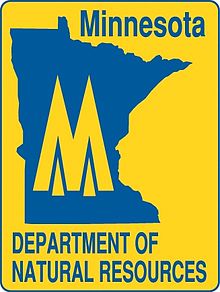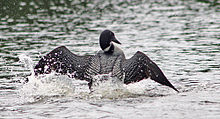- Minnesota Department of Natural Resources
-
The Minnesota Department of Natural Resources is the agency of the U.S. state of Minnesota charged with conserving and managing the state's natural resources. The agency maintains areas such as state parks, state forests, recreational trails, and recreation areas as well as managing minerals, wildlife, and forestry. The agency is currently divided into sections Ecological Resources, Enforcement, Fish & Wildlife, Forestry, Lands and Minerals, Waterways, Parks and Trails, and Waters.
Contents
History
Efforts to conserve Minnesota's wildlife began as early as 1876, with a forestry association established to protect the state's timber resources. However, those efforts became futile as the industry took over and people sought the money that could be made on the land. Over time, there were other attempts to control the destruction of resources, but most only had effects on what was done to public land, such as the Land Commission established in 1885. In 1911 the Minnesota Forest Service was established to conserve the state's forests by promoting fire prevention and protection.[1]
The first agency created to maintain Minnesota's resources was founded in 1931 as the Department of Conservation.[2] When the Department of Conservation was created, it brought together four separate state entities: forestry, game and fish, drainage and waters, and lands and timber, while adding a division of state parks and a tourist bureau as well. The Great Depression was an important time for the Department of Conservation. Federal unemployment programs such as the Civilian Conservation Corps and the Works Progress Administration provided labor to construct buildings, clear trails, and plant trees. Many of the buildings in Minnesota's state parks were built during this period.
In 1971 the name of the agency was changed to the Department of Natural Resources to "better reflect its broader responsibilities."[2] More sections of the Minnesota Government were added to the Department and many of the division names changed. Old policies were replaced with new and more prevalent ones geared towards new issues associated with an increase in state land use.
Divisions
Ecological Resources
The Division of Ecological Resources studies the ecosystems within Minnesota. They analyze the information in order to understand how the ecosystems function, how they benefit the citizens of Minnesota, how they are impacted by human use, and what long term effects will take place on the health of the ecosystems. The division is involved in locating and protecting endangered and threatened species, as well as the habitats that are vital to the conservation of those species. Another part of the division's responsibilities is in managing threats against the ecosystem. These threats include: harmful invasive species, fish and wildlife diseases, and the negative impact human development can have on the environment. One of the largest programs that the Division of Ecological Resources is in charge of is Minnesota’s Nongame Wildlife Program, which focuses on the conservation of species that are not hunted. This would include trumpeter swans, bald eagles and Minnesota’s state bird, the common loon.
Enforcement
As the name implies, the division focuses on the enforcement of Minnesota’s natural resource laws. Originally part of the Fish and Game Division, the Enforcement Division’s goal has not changed much: keep the public safe. Conservation Officers employed by this division enforce laws regarding hunting, fishing, trapping, recreational vehicles, State Parks and Wild rice harvesting. A second focus is educating the public about safety. Classes are taught by trained volunteers and are often related to the enforced laws. [3] The division also enforces air and water quality la
Fish and Wildlife
The Division of Fish and Wildlife was part of the original Department of Conservation. Originally called the Fish and Game Division, it was created to manage, protect and regulate the state’s fish and wildlife resource.[3] This division manages all of the lands acquired by the Department of Natural Resources. An example of this is on sister lakes, Lake Maria and Lake Sarah, in Murray Country where the DNR bought 640 acres (2.6 km2) of land between the two lakes to help improve water quality.[4] They also disperse licenses and recreational vehicle registrations throughout Minnesota.
Forestry
The Division of Forestry was founded in 1911 as the Minnesota Forest Service, predating the Department of Natural Resources and its predecessor Department of Conservation. The mission of the Division of Forestry is to maintain healthy forests. This is done through cooperative forest management, fire management and state land management.[3]
Parks and Trails
This division was also part of the Minnesota Forestry Service until it was given its own division in the Department of Conservation in 1935.[1] The Division of Parks and Trails has three major goals. The first being to preserve both natural and cultural resources in Minnesota. The second comes in educating visitors of the 73 State Parks. And the third goal is to opportunities for visitors to enjoy recreational activities in the parks, without causing damage to the wildlife, so people will be able to appreciate the resources for generations.[3]
Waterways
Waterways take part in the effort to publish individual water access maps by county, individual state trail maps, snowmobile trail maps, Off Highway Vehicle trail maps, Lake Superior Kayak Trail maps as well as maps of rivers within Minnesota for boaters and canoeists.
Waters
The Waters division is accountable for all lakes, rivers and streams, wetlands, and ground waters within the state.[3] The division enforces permits implemented to protect and preserve Minnesota's water resources. The program works on observing the effects of climate on the water resources and analyzes the data in order to understand and address the impact the climate has on the Minnesota's wildlife and its citizens.
Publications
The Minnesota Department of Natural resources publishes a magazine called the Minnesota Conservation Volunteer.[5] The magazine is distributed bimonthly, mailed to subscribers the first week of January, March, May, July, September, and November. The Minnesota Conservation Volunteer is a "donor-supported magazine advocating conservation and careful use of Minnesota's natural resources."[5] Most of the articles are also made available on the official DNR website.
Volunteering
Much of the services provided by the Minnesota DNR are actually done by the more than 33,000 volunteers that actively contribute. The Department has volunteer positions ranging from jobs that require little to no prior experience, to jobs that require specialists with varying skills and a great amount of experience. There are over a dozen specific volunteer programs offered through the DNR that aim to preserve the state's natural beauty.
Commissioners
Commissioners of the DNR since its formation in 1931:
- William T. Cox Aug. 20, 1931-Feb. 1933
- E.V. Willard (acting) Feb. 1933-Sept. 1933
- E.V. Willard Sept. 1933-July 1937
- Herman C. Wenzel July 1, 1937-April 26, 1939
- Lester R. Badger (acting) April 26, 1939-July 1939
- Lewis H. Merrill (acting) July 14, 1939-1939
- William L. Strunk Feb. 1, 1940-Feb. 1, 1943
- E.V. Willard Feb. 1, 1943-March 16, 1943
- Chester S. Wilson March 16, 1943-March 15, 1955
- Clarence Prout (acting) March 15, 1955-May 1, 1955
- George A. Selke May 1, 1955–1960
- Clarence Prout Jan. 4, 1961-July 1, 1963
- Wayne H. Olson July 1, 1963-July 16, 1966
- Robert L. Herbst (acting) July 16, 1966-Feb. 14, 1967
- Jarle B. Leirfallom Jan. 20, 1967-Jan. 1971
- Robert L. Herbst Jan. 4, 1971-Feb. 16, 1977
- Michael C. O'Donnell (acting) Feb. 1977-June 30, 1977
- William B. Nye July 5, 1977-June 30, 1978
- Joseph N. Alexander July 1, 1978-Jan. 4, 1991
- Rodney W. Sando Jan. 3, 1991-Jan. 4, 1999
- Ronald Nargang (acting) Jan. 4, 1999-Jan. 13, 1999
- Alan Horner Jan. 13, 1999-Jan.19, 1999
- Raymond B. Hitchcock (acting) Jan. 20, 1999-Feb. 14, 1999
- Allen Garber Feb. 15, 1999-Jan. 3, 2003
- Brad Moore (acting) Jan. 6, 2003-Jan. 20, 2003
- Gene Merriam Jan. 27, 2003-Jan. 2, 2007
- Mark Holsten Jan. 3, 2007–Jan. 3, 2011
- Laurie Martinson (acting) Jan. 4, 2011-Jan. 5, 2011
- Tom Landwehr Jan. 6, 2011-Present
External links
References
- ^ a b Meyer, Roy Willard (1991). Everyone's Country Estate: A History of Minnesota's State Parks. Minnesota Historical Society Press. ISBN 0-87351-266-9.
- ^ a b Breining, Greg (2008). "History of the DNR". Minnesota DNR. http://www.dnr.state.mn.us/aboutdnr/history/dnr.html. Retrieved 2008-02-25.[dead link]
- ^ a b c d e "About the DNR". Minnesota DNR. All data came from their respective website on the DNR's server. http://www.dnr.state.mn.us/aboutdnr/index.html. Retrieved 2008-02-28.
- ^ "DNR acquisition a boon for fish, wildlife and clean water". News Release. Minnesota DNR. 2008-01-25. http://news.dnr.state.mn.us/index.php/2008/01/25/dnr-acquisition-a-boon-for-fish-wildlife-and-clean-water/. Retrieved 2008-02-25.
- ^ a b "Minnesota Conservation Volunteer". Magazine. Minnesota DNR. 2008. http://www.dnr.state.mn.us/volunteer/index.html. Retrieved 2008-03-01.
Categories:- State law enforcement agencies of Minnesota
- Government of Minnesota
- State environmental protection agencies of the United States
Wikimedia Foundation. 2010.


